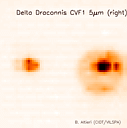


In the CVF stray-light experiment we move a point source over several detector positions. It can be seen that the stray-light pattern is a function of source position on the detector, and of lens and wavelength.
The most dramatic stray-light pattern is found for the 6 arcsec lens, where pixel illumination by scattered light from the primary source is typically below 3% of the corresponding source maximum for most positions of the source on the array. There are a few source locations however, for which the integrated lfux of the ghost contains 15% of the source light. For a source placed at the centre of the field of view the ghost falls back onto the source, so for point source photometry it is not a big problem, though it might affect the detailed appearance of some extended sources.
Click on the following link to see an MPEG movie of the CVF stray-light test in the 6 arcsec lens for a single CVF step position centered ar 5 microns.
For those without access to an MPEG player, a sequence of three images from the movie, with the source moving from left to right, can be seen below (click on any image to retrieve full size version). Alternatively, a non-looping animated gif (or 10 loop animated gif) is also available.



The ISOCAM instrument team designed further dedicated stray-light calibration observations and already special engineering ISO observing time has been granted by the project scientist for ongoing investigations. This should ensure the possibility to quantitatively examine the stray-light phenomenon of CAM04 in the future.
Ralf Siebenmorgen for CIDT.
 [Home Page |
CAM Instrument Page]
[Home Page |
CAM Instrument Page]